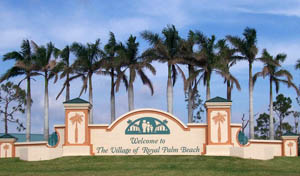Royal Palm Beach staff and contractor Clarke Aquatic Services reported last week that they are gaining control of aquatic weeds in the village’s canals.
At the April 17 meeting of the Royal Palm Beach Village Council, Utilities Director Paul Webster said Clarke’s contract calls for 90 percent control of exotic aquatic weeds and 85 percent control of floating weeds and algae, and to maintain control of aquatic plants with consideration of flood control, fishing, boating and aesthetics.
Webster also pointed out that last year, Clarke’s contract was amended to include a full-system treatment strategy, and that the village was recently issued a special permit by the Indian Trail Improvement District to let it do the primary maintenance on the M-1 Canal, which has been a source of complaints from village residents.
“Our agreement with Clarke was amended this month to include that,” Webster said, pointing out that the village is in its third and final year of the agreement with Clarke.
The condition of the canals as of the end of March was 97.9 percent clear in the village waterways and 90 percent clear in the M-1 Canal, Webster said. The M-1 Canal had floating tape grass throughout, and other sections of the waterways had tape grass and hygrophila floating in from the M-1 Canal.
“In our six-month comparison from the end of September last fall to the current conditions at the end of March, we see improvement throughout the system,” Webster said.
Clarke did soundings of the canals in March to detect submerged growth and muck and made maps of the entire system. “Those species like to grow in muckier areas,” Webster said. “It also helps us do a baseline for development of our future dredging program.”
Clarke Water Resources Manager Dr. Brett Bultemeier said that although visual inspections are done, the sonographs reveal bottom conditions that cannot be seen.
“These waterways are a little bit darker, where you can’t see more than 3 or 4 feet into the water, and you can have an awful lot of plants growing underneath there. By the time you see it, it’s almost too late,” he said. “The idea with the mapping is to identify the problems before they can be seen visually.”
Bultemeier described his company’s sounding equipment as a “fish-finder on steroids” that reveals the muck, the actual bottom of the canal and any plants growing there, giving recorded data of the conditions.
“Looking at this gives us a complete understanding of the entire system, so that rather than try to remember what we saw as we drove through, we have data-driven information that we can utilize to be proactive,” he said. “Instead of waiting for the plants to be almost at the surface, we can catch it early on before it becomes something worse.”
Bultemeier also pointed out that the collection of the data gives the village a historical record of the system. “It allows you each year to go back and determine if things are getting better,” he said. “It also provides the ability should you get calls from residents who say, ‘This is the worst it has ever looked,’ for you to say, ‘No, we can go back in history and see it is a lot better.’”
Along with an improvement in the vegetation, they are seeing an improvement in the sediment as well. “We are seeing an improvement in that sediment shifting to more of a hard sediment,” Bultemeier said. “As we open up that area, natural processes are allowed to turn that muck sediment into more of a sand.”
He said the generally clearer canals will give the company a head start as they move into summer, when growth is more pervasive.
Taking over control of the M-1 Canal, where many of the plants are coming from, will also help in controlling the weeds over the summer, Bultemeier added.
South Regional Operations Manager Angelo Fanelli said the company was in the process of treating the entire canal system as the growing season begins, then will follow up with a systemic treatment for new sprouts.
“We’ll be selective as much as possible to keep the more desirable plants on the shoreline, reduce erosion and help keep out undesirable plants,” Fanelli said, explaining that Clarke’s main focus is on eliminating non-native plants that tend to be more aggressive and retaining native plants that are good fish habitat.
Asked how the non-native plants get there, Bultemeier said it is often from residents who dump aquarium contents into the water.
“Somebody has a beautiful fish aquarium, they get tired, the fish die, they forget to feed them when they go on vacation, they come home, dump it into the canal, and now you have a mess,” Bultemeier said. “A singe node of that plant can float to a nice, soft spot and grow into an entire canal full of plants.”
Boaters can also bring them in, as well as birds and other animals.
Bultemeier said the company is getting to the point of being ahead of the plant control curve after a period last summer when numerous residents were complaining about aquatic weeds.
“The mapping helps a lot with that, and we’re taking steps to see that we stay ahead of it,” he said.








